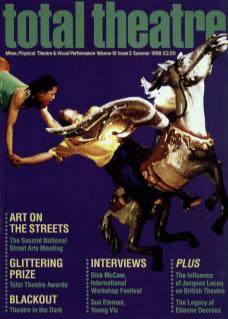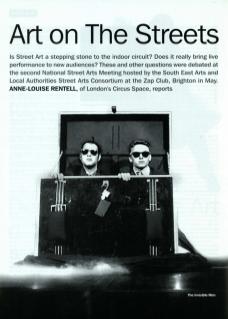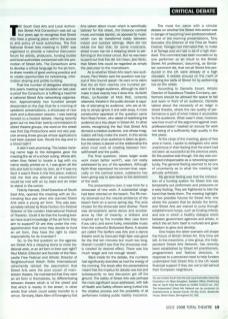The South East Arts and Local Authorities Street Arts Consortium was set up four years ago to recognise that Street Arts have a growing place within the access to arts policy of local authorities. The first National Street Arts meeting in 1997 was organised to provide a national discussion forum for artists, producers, funding bodies and local authorities concerned with the promotion of Street Arts. The Consortium aims to develop a critical language for the artform, to share models of good working practice and to create opportunities for networking, information sharing and profile building.
That the number of delegates attending this year's meeting had doubled on last year, is proof the Consortium is fulfilling a need for a national Street Arts networking organisation. Approximately two hundred people descended on the Zap Club for a morning of speakers' presentations, a showcase of new work, and a discussion session. I was looking forward to a heated debate. Having recently given out no less than twenty commissions to street theatre groups, the word on the street was that Zap Productions were not very popular among those groups whose applications had been passed over. Would the day end in a blood bath?
It didn't look promising. The ladies handing name tags to the delegates gave the meeting the air of a school outing. Worse still, when they failed to locate a tag with my name neatly printed on it, I was given all the bits and told to make my own; as if it was my fault it wasn't there in the first place. Instinct told me that any attempt at insurrection would be met with an icy stare and an order to stand in the corner.
Felicity Harvest, Chief Executive of South East Arts, opened the meeting with an illuminating faux pas when she claimed Street Arts were a young artform. This was passionately refuted by Rose Fenton (Co-Festival Director of the London International Festival of Theatre). Could it be that the funding bodies have scant knowledge of the artform they aim to support? Or are they under the misapprehension that once they decide to fund an artform, they have the right to claim responsibility for its invention?
So, to the first question on the agenda: are Street Arts a stepping stone to more traditional work, or an artform in their own right? Paul Miskin (Director and founder of the Newcastle Free Festival and Artistic Director of Neighbourhood Watch Stilts International) vehemently refuted the assumption that Street Arts were the poor cousin of mainstream theatre. He maintained that they were an artform in themselves, by differentiating between theatre which is ‘of the street' and that which is merely ‘in the street', in other words that which could easily transfer to a venue. Similarly, Mark Allen of Emergency Exit Arts talked about music which is specifically tailored for the street (for instance carnival music and brass bands), as opposed to music which can be transferred easily between indoor and outdoor settings. Mark did not refute the fact that, for some musicians, street music can be a stepping stone to performing on the indoor circuit. But he was keen to point out that this did not mean, ipso facto, that Street Arts could be regarded as simply the precursor to the mainstream.
As to whether Street Arts reach new audiences, Paul Miskin said the question was typical of ‘Arts Council speak'. He went on to claim that the artform reaches one hundred percent of its target audience, although he didn't make it clear exactly how it does this. As Keith Khan, co-founder of Moti Roti, correctly observed, theatre in the public domain is capable of alienating its audience, who are at liberty to simply ignore it and walk away. A more constructive appraisal of the question came from Rose Fenton, who talked of redefining the audience as a key player in Street Arts. In other words, recognising the fact that Street Arts demand a creative audience, one whose imagination will help make the event. In this sense the existence of an audience is taken as given, but the stress is placed on the relationship the artist must work at creating between himself/herself and the public.
The final question (does larger scale work mean better work?) was not really addressed by any of the speakers. Although Keith Khan expressed his concern that, especially on the carnival scene, substance has been giving way to spectacle to the detriment of the work.
The presentations over, it was time for a showcase of new work. A substantial stage had been erected on the beach. The PA merrily drowned out the natural ambience of the beach front on a sunny spring day. The acts chosen for the showcase were diverse. There was atmospheric aerial dance and acrobalance by Heir of Insanity; a brilliant and inspired act by The Invisible Men (see them if you can); and some funky, irresistible music from the colourful Bollywood Band. A double act called The Golfers was dire and a dance theatre work by Carousel-High Spin was good for the first ten minutes but much too long. Overall I couldn't see that the showcase really created its desired effect. There was too much 'stage’ and not enough 'street'.
Back inside for the debate, the numbers had significantly dwindled as had the energy of the morning. The break after the presentations meant that the impetus for debate was lost and subsequently no real discussion got off the ground. The safety of Street Arts was perhaps the most significant issue addressed, with talk of Health and Safety officers being invited into the creative process and the possibility of all performers holding public liability insurance.
The most fun came with a circular debate on whether the Street Arts sector was in danger of becoming 'over-professionalised'. In one of the morning presentations, Tony Gonzalez (Co-Director of the Fira de Teatro Festival, Tarrega) had intimated that, to make it at Tarrega, your act had to be of a high standard. This comment had been rounded on by one performer as an insult to the British Street Arts profession, assuming, as Gonzalez's comment did, that not all Street Arts produced in the UK were already of a high standard. A debate ensued on the merit of learning the skills of Street Arts by performing live on the street.
According to Daniella Essart, Artistic Director of Scarabeus Theatre Company, performers should be allowed the space to fail and learn in front of an audience. Daniella talked about the necessity of an 'edge’ in street theatre, where the raw quality of performance is part of what makes it accessible to the audience. What wasn't clear, however, was how much of the argument against 'over-professionalism' masked an excuse for work not being of a sufficiently high quality in the first place.
At the close of the meeting, glass of free wine in hand, I spoke to delegates who were unanimous in their feeling that the event had not been as successful as the previous year's. On the positive side though, the day was considered indispensable as a networking opportunity. The general feeling seemed to be one of uncertainty as to what the meeting had actually achieved.
My general feeling was that the introduction of a funding system for Street Arts has temporarily put performers and producers on a wary footing. They are frightened to bite the hand that feeds them. The meeting highlighted two possible futures for Street Arts: one where the powers that be dictate the terms, and Street Arts are trained to jump through establishment hoops, such as funding criteria; and one in which a healthy dialogue exists between government agencies and artists, in which the artform itself is nurtured and given freedom to grow and develop.
One hopes the latter scenario will shape the future of British Street Arts. Only time will tell. In the meantime, a new group, the Independent Street Arts Network, has recently been established by Street Arts practitioners, programmers and festival directors, in response to a perceived need to help funders understand that Street Arts in the UK needs financial support if they are not to fall behind their European neighbours.


